distributors.scad
Functions and modules to distribute children or copies of children onto a line, a grid, or an arbitrary path. The $idx mechanism means that the "copies" of children can vary. Also includes shortcuts for mirroring.
To use, add the following lines to the beginning of your file:
include <BOSL2/std.scad>
-
Section: Translating copies of all the children
-
move_copies()– Translates copies of all children. [MatList] [Trans] -
xcopies()– Places copies of children along the X axis. [MatList] [Trans] -
ycopies()– Places copies of children along the Y axis. [MatList] [Trans] -
zcopies()– Places copies of children along the Z axis. [MatList] [Trans] -
line_copies()– Places copies of children along an arbitrary line. [MatList] [Trans] -
grid_copies()– Places copies of children in an [X,Y] grid. [MatList] [Trans]
-
-
Section: Rotating copies of all children
-
rot_copies()– Rotates copies of children. [MatList] [Trans] -
xrot_copies()– Rotates copies of children around the X axis. [MatList] [Trans] -
yrot_copies()– Rotates copies of children around the Y axis. [MatList] [Trans] -
zrot_copies()– Rotates copies of children around the Z axis. [MatList] [Trans] -
arc_copies()– Distributes duplicates of children along an arc. [MatList] [Trans] -
sphere_copies()– Distributes copies of children over the surface of a sphere. [MatList] [Trans]
-
-
Section: Placing copies of all children on a path
-
path_copies()– Uniformly distributes copies of children along a path. [MatList] [Trans]
-
-
Section: Making a copy of all children with reflection
-
xflip_copy()– Makes a copy of children mirrored across the X axis. [MatList] [Trans] -
yflip_copy()– Makes a copy of children mirrored across the Y axis. [MatList] [Trans] -
zflip_copy()– Makes a copy of children mirrored across the Z axis. [MatList] [Trans] -
mirror_copy()– Makes a copy of children mirrored across a given plane. [MatList] [Trans]
-
-
Section: Distributing children individually along a line
-
xdistribute()– Distributes each child, individually, out along the X axis. [Trans] -
ydistribute()– Distributes each child, individually, out along the Y axis. [Trans] -
zdistribute()– Distributes each child, individually, out along the Z axis. [Trans] -
distribute()– Distributes each child, individually, out along an arbitrary line. [Trans]
-
The distributor methods create multiple copies of their children and place them in various ways. While many models
require multiple identical copies of an object, this framework is more powerful than
might be immediately obvious because of $ variables. The distributors set $ variables that the children can use to change their
behavior from one child to the next within a single distributor invocation. This means the copies need not be identical.
The xcopies() module sets $idx to the index number of the copy, and in the examples below we use $idx, but the various
distributors offer a variety of $ variables that you can use in your children. Check the "Side Effects" section for each module
to learn what variables that module provides.
Two gotchas may lead to models that don't behave as expected. While if statements work to control modules, you cannot
use them to make variable assignments in your child object. If you write a statement like
if (condition) { c="red";}
else {c="green";}
then the c variable is set only in the scope of the if and else clauses and is not available later on when you actually
try to use it. Instead you must use the ternary operator and write:
c = condition ? "red" : "green";
The second complication is
that in OpenSCAD version 2021.01 and earlier, assignments in children were executed before their parent. This means
that $ variables like $idx are not available in assignments because the parent hasn't run to set them, so if you use them
you will get a warning about an unknown variable.
Two workarounds exist, neither of which are needed in newer versions of OpenSCAD. The workarounds solve the problem because
modules execute after their parent, so the $ variables are available in modules. You can put your assignments
in a let() module, or you can wrap your child in a union(). Both methods appear below.
Figure 1: This example shows how we can use $idx to produce different geometry at each index.

xcopies(n=10, spacing=10)
text(str($idx));
Figure 2: Here the children are sometimes squares and sometimes circles as determined by the conditional if module. This use of if is OK because no variables are assigned.

xcopies(n=4, spacing=10)
if($idx%2==0) circle(r=3,$fn=16);
else rect(6);
Figure 3: Suppose we would like to color odd and even index copies differently. In this example we compute the color for a given child from $idx using the ternary operator. The let() module is a module that sets variables and makes them available to its children. Note that multiple assignments in let() are separated by commas, not semicolons.

xcopies(n=6, spacing=10){
let(c = $idx % 2 == 0 ? "red" : "green")
color(c) rect(6);
}
Figure 4: This example shows how you can change the position of children adaptively. If you want to avoid repeating your code for each case, this requires storing a transformation matrix in a variable and then applying it using multmatrix(). We wrap our code in union() to ensure that it works in OpenSCAD 2021.01.

xcopies(n=5,spacing=10)
union()
{
shiftback = $idx%2==0 ? back(10) : IDENT;
spin = zrot(180*$idx/4);
multmatrix(shiftback*spin) stroke([[-4,0],[4,0]],endcap2="arrow2",width=3/4,color="red");
}
Synopsis: Translates copies of all children. [MatList] [Trans]
Topics: Transformations, Distributors, Translation, Copiers
See Also: xcopies(), ycopies(), zcopies(), line_copies(), grid_copies(), rot_copies(), xrot_copies(), yrot_copies(), zrot_copies(), arc_copies(), sphere_copies()
Usage:
- move_copies(a) CHILDREN;
Usage: As a function to translate points, VNF, or Bezier patches
- copies = move_copies(a, p=);
Usage: Get Translation Matrices
- mats = move_copies(a);
Description:
When called as a module, translates copies of all children to each given translation offset.
When called as a function, with no p= argument, returns a list of transformation matrices, one for each copy.
When called as a function, with a p= argument, returns a list of transformed copies of p=.
Arguments:
| By Position | What it does |
|---|---|
a |
Array of XYZ offset vectors. Default [[0,0,0]]
|
| By Name | What it does |
|---|---|
p |
Either a point, pointlist, VNF or Bezier patch to be translated when used as a function. |
Side Effects:
-
$posis set to the relative centerpoint of each child copy, and can be used to modify each child individually. -
$idxis set to the index number of each child being copied.
Example 1:

include <BOSL2/std.scad>
#sphere(r=10);
move_copies([[-25,-25,0], [25,-25,0], [0,0,50], [0,25,0]]) sphere(r=10);
Synopsis: Places copies of children along the X axis. [MatList] [Trans]
Topics: Transformations, Distributors, Translation, Copiers
See Also: move_copies(), ycopies(), zcopies(), line_copies(), grid_copies(), rot_copies(), xrot_copies(), yrot_copies(), zrot_copies(), arc_copies(), sphere_copies()
Usage:
- xcopies(spacing, [n], [sp=]) CHILDREN;
- xcopies(l=, [n=], [sp=]) CHILDREN;
- xcopies(LIST) CHILDREN;
Usage: As a function to translate points, VNF, or Bezier patches
- copies = xcopies(spacing, [n], [sp=], p=);
- copies = xcopies(l=, [n=], [sp=], p=);
- copies = xcopies(LIST, p=);
Usage: Get Translation Matrices
- mats = xcopies(spacing, [n], [sp=]);
- mats = xcopies(l=, [n=], [sp=]);
- mats = xcopies(LIST);
Description:
When called as a module, places n copies of the children along a line on the X axis.
When called as a function, without a p= argument, returns a list of transformation matrices, one for each copy.
When called as a function, with a p= argument, returns a list of transformed copies of p=.
Arguments:
| By Position | What it does |
|---|---|
spacing |
Given a scalar, specifies a uniform spacing between copies. Given a list of scalars, each one gives a specific position along the line. (Default: 1.0) |
n |
Number of copies to place. (Default: 2) |
| By Name | What it does |
|---|---|
l |
If given, the length to place copies over. |
sp |
If given as a point, copies will be placed on a line to the right of starting position sp. If given as a scalar, copies will be placed on a line segment to the right of starting position [sp,0,0]. If not given, copies will be placed along a line segment that is centered at [0,0,0]. |
p |
Either a point, pointlist, VNF or Bezier patch to be translated when used as a function. |
Side Effects:
-
$posis set to the relative centerpoint of each child copy, and can be used to modify each child individually. -
$idxis set to the index number of each child being copied.
Example 1:
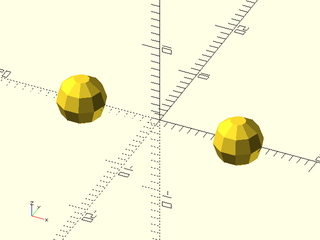
include <BOSL2/std.scad>
xcopies(20) sphere(3);
Example 2:

include <BOSL2/std.scad>
xcopies(20, n=3) sphere(3);
Example 3:
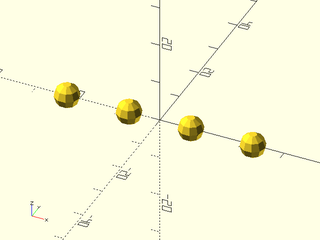
include <BOSL2/std.scad>
xcopies(spacing=15, l=50) sphere(3);
Example 4:

include <BOSL2/std.scad>
xcopies(n=4, l=30, sp=[0,10,0]) sphere(3);
Example 5:
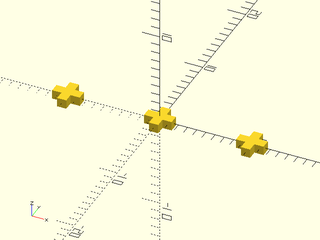
include <BOSL2/std.scad>
xcopies(10, n=3) {
cube(size=[1,3,1],center=true);
cube(size=[3,1,1],center=true);
}
Example 6:
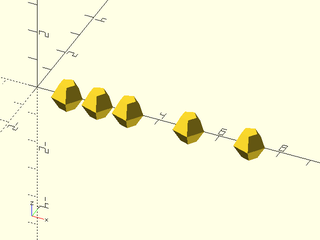
include <BOSL2/std.scad>
xcopies([1,2,3,5,7]) sphere(d=1);
Synopsis: Places copies of children along the Y axis. [MatList] [Trans]
Topics: Transformations, Distributors, Translation, Copiers
See Also: move_copies(), xcopies(), zcopies(), line_copies(), grid_copies(), rot_copies(), xrot_copies(), yrot_copies(), zrot_copies(), arc_copies(), sphere_copies()
Usage:
- ycopies(spacing, [n], [sp=]) CHILDREN;
- ycopies(l=, [n=], [sp=]) CHILDREN;
- ycopies(LIST) CHILDREN;
Usage: As a function to translate points, VNF, or Bezier patches
- copies = ycopies(spacing, [n], [sp=], p=);
- copies = ycopies(l=, [n=], [sp=], p=);
- copies = ycopies(LIST, p=);
Usage: Get Translation Matrices
- mats = ycopies(spacing, [n], [sp=]);
- mats = ycopies(l=, [n=], [sp=]);
- mats = ycopies(LIST);
Description:
When called as a module, places n copies of the children along a line on the Y axis.
When called as a function, without a p= argument, returns a list of transformation matrices, one for each copy.
When called as a function, with a p= argument, returns a list of transformed copies of p=.
Arguments:
| By Position | What it does |
|---|---|
spacing |
Given a scalar, specifies a uniform spacing between copies. Given a list of scalars, each one gives a specific position along the line. (Default: 1.0) |
n |
Number of copies to place on the line. (Default: 2) |
| By Name | What it does |
|---|---|
l |
If given, the length to place copies over. |
sp |
If given as a point, copies will be place on a line back from starting position sp. If given as a scalar, copies will be placed on a line back from starting position [0,sp,0]. If not given, copies will be placed along a line that is centered at [0,0,0]. |
p |
Either a point, pointlist, VNF or Bezier patch to be translated when used as a function. |
Side Effects:
-
$posis set to the relative centerpoint of each child copy, and can be used to modify each child individually. -
$idxis set to the index number of each child being copied.
Example 1:

include <BOSL2/std.scad>
ycopies(20) sphere(3);
Example 2:
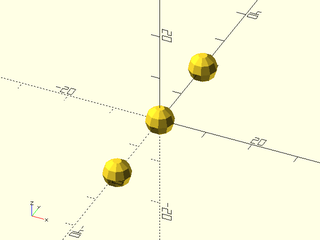
include <BOSL2/std.scad>
ycopies(20, n=3) sphere(3);
Example 3:

include <BOSL2/std.scad>
ycopies(spacing=15, l=50) sphere(3);
Example 4:
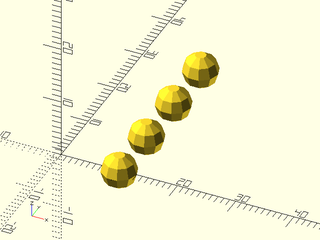
include <BOSL2/std.scad>
ycopies(n=4, l=30, sp=[10,0,0]) sphere(3);
Example 5:
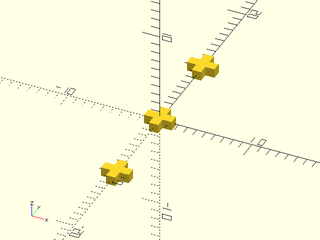
include <BOSL2/std.scad>
ycopies(10, n=3) {
cube(size=[1,3,1],center=true);
cube(size=[3,1,1],center=true);
}
Example 6:
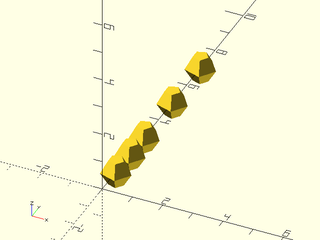
include <BOSL2/std.scad>
ycopies([1,2,3,5,7]) sphere(d=1);
Synopsis: Places copies of children along the Z axis. [MatList] [Trans]
Topics: Transformations, Distributors, Translation, Copiers
See Also: move_copies(), xcopies(), ycopies(), line_copies(), grid_copies(), rot_copies(), xrot_copies(), yrot_copies(), zrot_copies(), arc_copies(), sphere_copies()
Usage:
- zcopies(spacing, [n], [sp=]) CHILDREN;
- zcopies(l=, [n=], [sp=]) CHILDREN;
- zcopies(LIST) CHILDREN;
Usage: As a function to translate points, VNF, or Bezier patches
- copies = zcopies(spacing, [n], [sp=], p=);
- copies = zcopies(l=, [n=], [sp=], p=);
- copies = zcopies(LIST, p=);
Usage: Get Translation Matrices
- mats = zcopies(spacing, [n], [sp=]);
- mats = zcopies(l=, [n=], [sp=]);
- mats = zcopies(LIST);
Description:
When called as a module, places n copies of the children along a line on the Z axis.
When called as a function, without a p= argument, returns a list of transformation matrices, one for each copy.
When called as a function, with a p= argument, returns a list of transformed copies of p=.
Arguments:
| By Position | What it does |
|---|---|
spacing |
Given a scalar, specifies a uniform spacing between copies. Given a list of scalars, each one gives a specific position along the line. (Default: 1.0) |
n |
Number of copies to place. (Default: 2) |
| By Name | What it does |
|---|---|
l |
If given, the length to place copies over. |
sp |
If given as a point, copies will be placed on a line up from starting position sp. If given as a scalar, copies will be placed on a line up from starting position [0,0,sp]. If not given, copies will be placed on a line that is centered at [0,0,0]. |
p |
Either a point, pointlist, VNF or Bezier patch to be translated when used as a function. |
Side Effects:
-
$posis set to the relative centerpoint of each child copy, and can be used to modify each child individually. -
$idxis set to the index number of each child being copied.
Example 1:

include <BOSL2/std.scad>
zcopies(20) sphere(3);
Example 2:

include <BOSL2/std.scad>
zcopies(20, n=3) sphere(3);
Example 3:
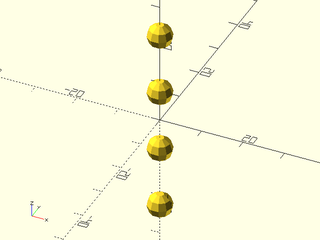
include <BOSL2/std.scad>
zcopies(spacing=15, l=50) sphere(3);
Example 4:

include <BOSL2/std.scad>
zcopies(n=4, l=30, sp=[10,0,0]) sphere(3);
Example 5:
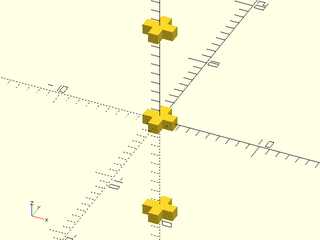
include <BOSL2/std.scad>
zcopies(10, n=3) {
cube(size=[1,3,1],center=true);
cube(size=[3,1,1],center=true);
}
Example 6: Cubic sphere packing
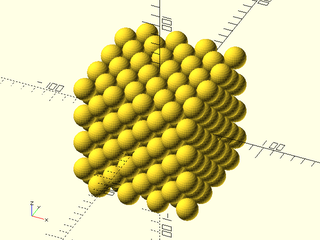
include <BOSL2/std.scad>
s = 20;
s2 = s * sin(45);
zcopies(s2,n=8)
grid_copies([s2,s2],n=8,stagger=($idx%2)? true : "alt")
sphere(d=s);
Example 7: Hexagonal sphere packing
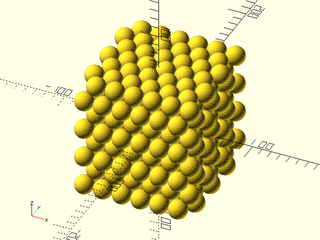
include <BOSL2/std.scad>
s = 20;
xyr = adj_ang_to_hyp(s/2,30);
h = hyp_adj_to_opp(s,xyr);
zcopies(h,n=8)
back(($idx%2)*xyr*cos(60))
grid_copies(s,n=[12,7],stagger=($idx%2)? "alt" : true)
sphere(d=s);
Example 8:
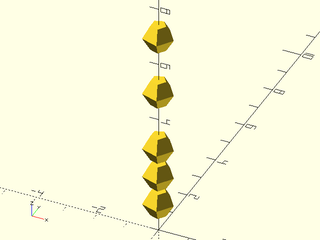
include <BOSL2/std.scad>
zcopies([1,2,3,5,7]) sphere(d=1);
Synopsis: Places copies of children along an arbitrary line. [MatList] [Trans]
Topics: Transformations, Distributors, Translation, Copiers
See Also: move_copies(), xcopies(), ycopies(), zcopies(), rot_copies(), xrot_copies(), yrot_copies(), zrot_copies(), arc_copies(), sphere_copies()
Usage: Place n copies at a given spacing along the line
- line_copies(spacing, [n], [p1=]) CHILDREN;
Usage: Place as many copies as will fit at a given spacing
- line_copies(spacing, [l=], [p1=]) CHILDREN;
Usage: Place n copies along the length of the line
- line_copies([n=], [l=], [p1=]) CHILDREN;
Usage: Place n copies along the line from p1 to p2
- line_copies([n=], [p1=], [p2=]) CHILDREN;
Usage: Place copies at the given spacing, centered along the line from p1 to p2
- line_copies([spacing], [p1=], [p2=]) CHILDREN;
Usage: As a function to translate points, VNF, or Bezier patches
- copies = line_copies([spacing], [n], [p1=], p=);
- copies = line_copies([spacing], [l=], [p1=], p=);
- copies = line_copies([n=], [l=], [p1=], p=);
- copies = line_copies([n=], [p1=], [p2=], p=);
- copies = line_copies([spacing], [p1=], [p2=], p=);
Usage: Get Translation Matrices
- mats = line_copies([spacing], [n], [p1=]);
- mats = line_copies([spacing], [l=], [p1=]);
- mats = line_copies([n=], [l=], [p1=]);
- mats = line_copies([n=], [p1=], [p2=]);
- mats = line_copies([spacing], [p1=], [p2=]);
Description:
When called as a function, without a p= argument, returns a list of transformation matrices, one for each copy.
When called as a function, with a p= argument, returns a list of transformed copies of p=.
When called as a module, copies children() at one or more evenly spaced positions along a line.
By default, the line will be centered at the origin, unless the starting point p1 is given.
The line will be pointed towards RIGHT (X+) unless otherwise given as a vector in l,
spacing, or p1/p2. The psotion of the copies is specified in one of several ways:
| If You Know... | Then Use Something Like... |
|---|---|
| Spacing distance, Count |
line_copies(spacing=10, n=5) ... or line_copies(10, n=5) ...
|
| Spacing vector, Count |
line_copies(spacing=[10,5], n=5) ... or line_copies([10,5], n=5) ...
|
| Spacing distance, Line length |
line_copies(spacing=10, l=50) ... or line_copies(10, l=50) ...
|
| Spacing distance, Line vector |
line_copies(spacing=10, l=[50,30]) ... or line_copies(10, l=[50,30]) ...
|
| Spacing vector, Line length |
line_copies(spacing=[10,5], l=50) ... or line_copies([10,5], l=50) ...
|
| Line length, Count | line_copies(l=50, n=5) ... |
| Line vector, Count | line_copies(l=[50,40], n=5) ... |
| Line endpoints, Count | line_copies(p1=[10,10], p2=[60,-10], n=5) ... |
| Line endpoints, Spacing distance | line_copies(p1=[10,10], p2=[60,-10], spacing=10) ... |
Arguments:
| By Position | What it does |
|---|---|
spacing |
Either the scalar spacing distance along the X+ direction, or the vector giving both the direction and spacing distance between each set of copies. |
n |
Number of copies to distribute along the line. (Default: 2) |
| By Name | What it does |
|---|---|
l |
Either the scalar length of the line, or a vector giving both the direction and length of the line. |
p1 |
If given, specifies the starting point of the line. |
p2 |
If given with p1, specifies the ending point of line, and indirectly calculates the line length. |
p |
Either a point, pointlist, VNF or Bezier patch to be translated when used as a function. |
Side Effects:
-
$posis set to the relative centerpoint of each child copy, and can be used to modify each child individually. -
$idxis set to the index number of each child being copied.
Example 1:
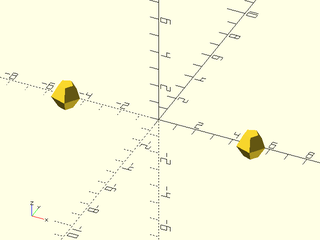
include <BOSL2/std.scad>
line_copies(10) sphere(d=1.5);
Example 2:
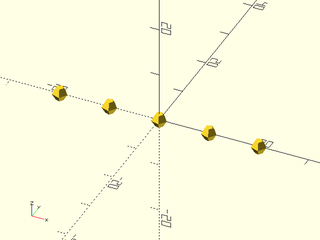
include <BOSL2/std.scad>
line_copies(10, n=5) sphere(d=3);
Example 3:
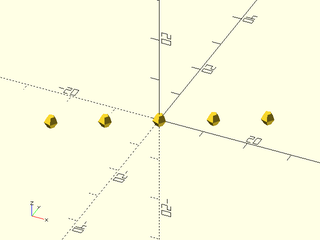
include <BOSL2/std.scad>
line_copies([10,5], n=5) sphere(d=3);
Example 4:
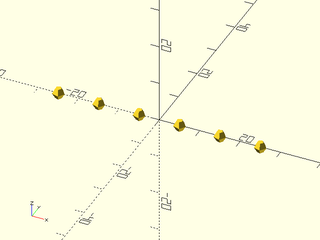
include <BOSL2/std.scad>
line_copies(spacing=10, n=6) sphere(d=3);
Example 5:

include <BOSL2/std.scad>
line_copies(spacing=[10,5], n=6) sphere(d=3);
Example 6:
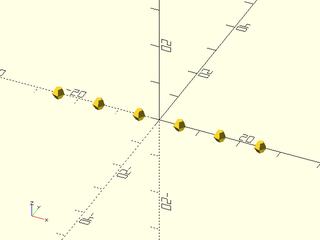
include <BOSL2/std.scad>
line_copies(spacing=10, l=50) sphere(d=3);
Example 7:

include <BOSL2/std.scad>
line_copies(spacing=10, l=[50,30]) sphere(d=3);
Example 8:
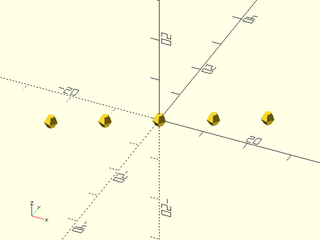
include <BOSL2/std.scad>
line_copies(spacing=[10,5], l=50) sphere(d=3);
Example 9:
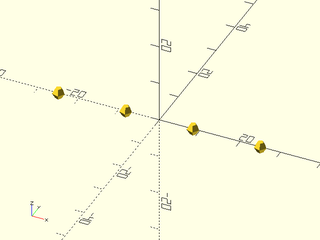
include <BOSL2/std.scad>
line_copies(l=50, n=4) sphere(d=3);
Example 10:
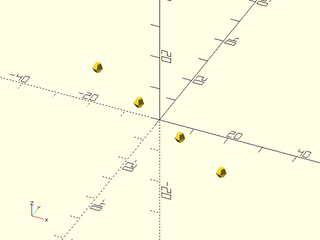
include <BOSL2/std.scad>
line_copies(l=[50,-30], n=4) sphere(d=3);
Example 11:

include <BOSL2/std.scad>
line_copies(p1=[0,0,0], p2=[5,5,20], n=6) cuboid([3,2,1]);
Example 12:
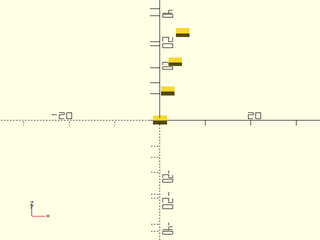
include <BOSL2/std.scad>
line_copies(p1=[0,0,0], p2=[5,5,20], spacing=6) cuboid([3,2,1]);
Example 13: All children are copied to each position

include <BOSL2/std.scad>
line_copies(l=20, n=3) {
cube(size=[1,3,1],center=true);
cube(size=[3,1,1],center=true);
}
Example 14: The functional form of line_copies() returns a list of transform matrices.
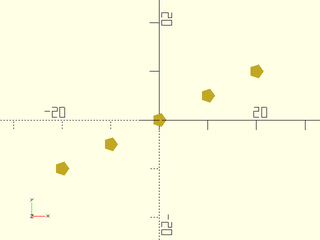
include <BOSL2/std.scad>
mats = line_copies([10,5],n=5);
for (m = mats) multmatrix(m) circle(d=3);
Example 15: The functional form of line_copies() returns a list of points if given a point.
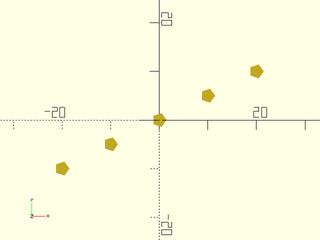
include <BOSL2/std.scad>
pts = line_copies([10,5],n=5,p=[0,0,0]);
move_copies(pts) circle(d=3);
Synopsis: Places copies of children in an [X,Y] grid. [MatList] [Trans]
Topics: Transformations, Distributors, Translation, Copiers
See Also: move_copies(), xcopies(), ycopies(), zcopies(), line_copies(), rot_copies(), xrot_copies(), yrot_copies(), zrot_copies(), arc_copies(), sphere_copies()
Usage:
- grid_copies(spacing, size=, [stagger=], [scale=], [inside=]) CHILDREN;
- grid_copies(n=, size=, [stagger=], [scale=], [inside=]) CHILDREN;
- grid_copies(spacing, [n], [stagger=], [scale=], [inside=]) CHILDREN;
- grid_copies(n=, inside=, [stagger], [scale]) CHILDREN;
Usage: As a function to translate points, VNF, or Bezier patches
- copies = grid_copies(spacing, size=, [stagger=], [scale=], [inside=], p=);
- copies = grid_copies(n=, size=, [stagger=], [scale=], [inside=], p=);
- copies = grid_copies(spacing, [n], [stagger=], [scale=], [inside=], p=);
- copies = grid_copies(n=, inside=, [stagger], [scale], p=);
Usage: Get Translation Matrices
- mats = grid_copies(spacing, size=, [stagger=], [scale=], [inside=]);
- mats = grid_copies(n=, size=, [stagger=], [scale=], [inside=]);
- mats = grid_copies(spacing, [n], [stagger=], [scale=], [inside=]);
- mats = grid_copies(n=, inside=, [stagger], [scale]);
Description:
When called as a module, makes a square or hexagonal grid of copies of children, with an optional masking polygon or region.
When called as a function, without a p= argument, returns a list of transformation matrices, one for each copy.
When called as a function, with a p= argument, returns a list of transformed copies of p=.
Arguments:
| By Position | What it does |
|---|---|
spacing |
Distance between copies in [X,Y] or scalar distance. |
n |
How many columns and rows of copies to make. Can be given as [COLS,ROWS], or just as a scalar that specifies both. If staggered, count both staggered and unstaggered columns and rows. Default: 2 (3 if staggered) |
size |
The [X,Y] size to spread the copies over. |
| By Name | What it does |
|---|---|
stagger |
If true, make a staggered (hexagonal) grid. If false, make square grid. If "alt", makes alternate staggered pattern. Default: false |
inside |
If given a list of polygon points, or a region, only creates copies whose center would be inside the polygon or region. Polygon can be concave and/or self crossing. |
nonzero |
If inside is set to a polygon with self-crossings then use the nonzero method for deciding if points are in the polygon. Default: false |
p |
Either a point, pointlist, VNF or Bezier patch to be translated when used as a function. |
Side Effects:
-
$posis set to the relative centerpoint of each child copy, and can be used to modify each child individually. -
$colis set to the integer column number for each child. -
$rowis set to the integer row number for each child. -
$idxis set to a unique index for each child, progressing across rows first, from the bottom
Example 1:
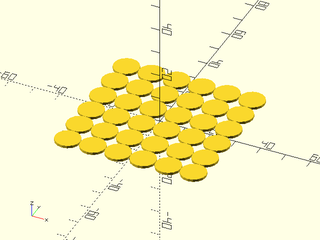
include <BOSL2/std.scad>
grid_copies(size=50, spacing=10) cylinder(d=10, h=1);
Example 2:
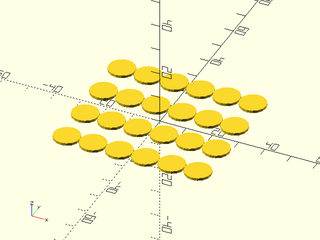
include <BOSL2/std.scad>
grid_copies(size=50, spacing=[10,15]) cylinder(d=10, h=1);
Example 3:
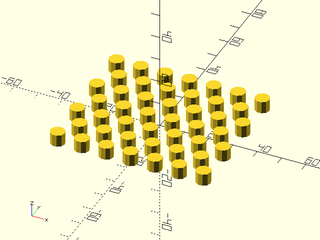
include <BOSL2/std.scad>
grid_copies(spacing=10, n=[13,7], stagger=true) cylinder(d=6, h=5);
Example 4:
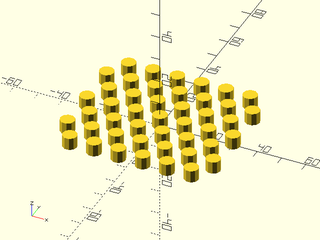
include <BOSL2/std.scad>
grid_copies(spacing=10, n=[13,7], stagger="alt") cylinder(d=6, h=5);
Example 5:
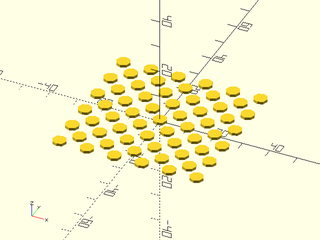
include <BOSL2/std.scad>
grid_copies(size=50, n=11, stagger=true) cylinder(d=5, h=1);
Example 6:
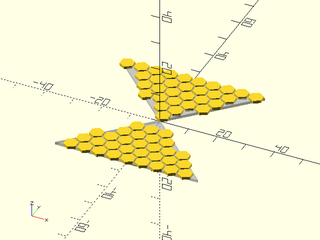
include <BOSL2/std.scad>
poly = [[-25,-25], [25,25], [-25,25], [25,-25]];
grid_copies(spacing=5, stagger=true, inside=poly)
zrot(180/6) cylinder(d=5, h=1, $fn=6);
%polygon(poly);
Example 7: Using $row and $col

include <BOSL2/std.scad>
grid_copies(spacing=8, n=8)
color(($row+$col)%2?"black":"red")
cube([8,8,0.01], center=false);
Example 8: Makes a grid of hexagon pillars whose tops are all angled to reflect light at [0,0,50], if they were shiny.
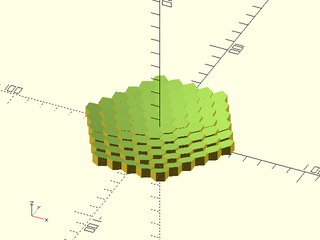
include <BOSL2/std.scad>
hexregion = circle(r=50.01,$fn=6);
grid_copies(spacing=10, stagger=true, inside=hexregion)
union() { // Needed for OpenSCAD 2021.01 as noted above
ref_v = (unit([0,0,50]-point3d($pos)) + UP)/2;
half_of(v=-ref_v, cp=[0,0,5])
zrot(180/6)
cylinder(h=20, d=10/cos(180/6)+0.01, $fn=6);
}
Synopsis: Rotates copies of children. [MatList] [Trans]
Topics: Transformations, Distributors, Rotation, Copiers
See Also: xrot_copies(), yrot_copies(), zrot_copies(), arc_copies(), sphere_copies(), move_copies(), xcopies(), ycopies(), zcopies(), line_copies(), grid_copies()
Usage:
- rot_copies(rots, [cp=], [sa=], [delta=], [subrot=]) CHILDREN;
- rot_copies(rots, v, [cp=], [sa=], [delta=], [subrot=]) CHILDREN;
- rot_copies(n=, [v=], [cp=], [sa=], [delta=], [subrot=]) CHILDREN;
Usage: As a function to translate points, VNF, or Bezier patches
- copies = rot_copies(rots, [cp=], [sa=], [delta=], [subrot=], p=);
- copies = rot_copies(rots, v, [cp=], [sa=], [delta=], [subrot=], p=);
- copies = rot_copies(n=, [v=], [cp=], [sa=], [delta=], [subrot=], p=);
Usage: Get Translation Matrices
- mats = rot_copies(rots, [cp=], [sa=], [delta=], [subrot=]);
- mats = rot_copies(rots, v, [cp=], [sa=], [delta=], [subrot=]);
- mats = rot_copies(n=, [v=], [cp=], [sa=], [delta=], [subrot=]);
Description:
When called as a module:
- Given a list of [X,Y,Z] rotation angles in
rots, rotates copies of the children to each of those angles, regardless of axis of rotation. - Given a list of scalar angles in
rots, rotates copies of the children to each of those angles around the axis of rotation. - If given a vector
v, that becomes the axis of rotation. Default axis of rotation is UP. - If given a count
n, makes that many copies, rotated evenly around the axis. - If given an offset
delta, translates each child by that amount before rotating them into place. This makes rings. - If given a centerpoint
cp, centers the ring around that centerpoint. - If
subrotis true, each child will be rotated in place to keep the same size towards the center when making rings. - The first (unrotated) copy will be placed at the relative starting angle
sa.
When called as a function, without a p= argument, returns a list of transformation matrices, one for each copy.
When called as a function, with a p= argument, returns a list of transformed copies of p=.
Arguments:
| By Position | What it does |
|---|---|
rots |
A list of [X,Y,Z] rotation angles in degrees. If v is given, this will be a list of scalar angles in degrees to rotate around v. |
v |
If given, this is the vector of the axis to rotate around. |
cp |
Centerpoint to rotate around. Default: [0,0,0]
|
| By Name | What it does |
|---|---|
n |
Optional number of evenly distributed copies, rotated around the axis. |
sa |
Starting angle, in degrees. For use with n. Angle is in degrees counter-clockwise. Default: 0 |
delta |
[X,Y,Z] amount to move away from cp before rotating. Makes rings of copies. Default: [0,0,0]
|
subrot |
If false, don't sub-rotate children as they are copied around the ring. Only makes sense when used with delta. Default: true
|
p |
Either a point, pointlist, VNF or Bezier patch to be translated when used as a function. |
Side Effects:
-
$angis set to the rotation angle (or XYZ rotation triplet) of each child copy, and can be used to modify each child individually. -
$idxis set to the index value of each child copy. -
$axisis set to the axis to rotate around, ifrotswas given as a list of angles instead of a list of [X,Y,Z] rotation angles.
Example 1:
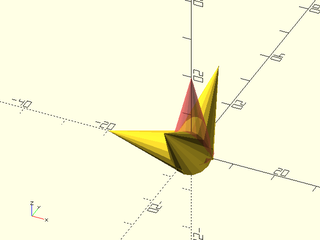
include <BOSL2/std.scad>
#cylinder(h=20, r1=5, r2=0);
rot_copies([[45,0,0],[0,45,90],[90,-45,270]]) cylinder(h=20, r1=5, r2=0);
Example 2:
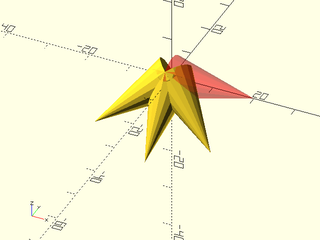
include <BOSL2/std.scad>
rot_copies([45, 90, 135], v=DOWN+BACK)
yrot(90) cylinder(h=20, r1=5, r2=0);
color("red",0.333) yrot(90) cylinder(h=20, r1=5, r2=0);
Example 3:
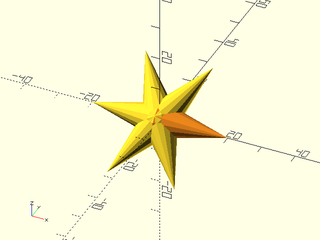
include <BOSL2/std.scad>
rot_copies(n=6, v=DOWN+BACK)
yrot(90) cylinder(h=20, r1=5, r2=0);
color("red",0.333) yrot(90) cylinder(h=20, r1=5, r2=0);
Example 4:
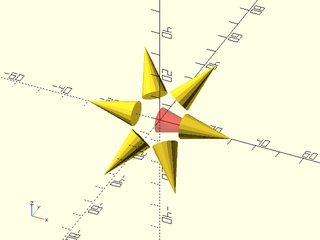
include <BOSL2/std.scad>
rot_copies(n=6, v=DOWN+BACK, delta=[10,0,0])
yrot(90) cylinder(h=20, r1=5, r2=0);
color("red",0.333) yrot(90) cylinder(h=20, r1=5, r2=0);
Example 5:
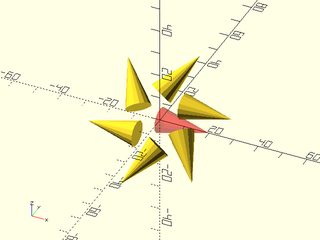
include <BOSL2/std.scad>
rot_copies(n=6, v=UP+FWD, delta=[10,0,0], sa=45)
yrot(90) cylinder(h=20, r1=5, r2=0);
color("red",0.333) yrot(90) cylinder(h=20, r1=5, r2=0);
Example 6:
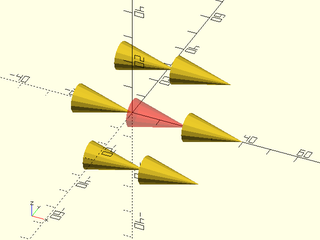
include <BOSL2/std.scad>
rot_copies(n=6, v=DOWN+BACK, delta=[20,0,0], subrot=false)
yrot(90) cylinder(h=20, r1=5, r2=0);
color("red",0.333) yrot(90) cylinder(h=20, r1=5, r2=0);
Synopsis: Rotates copies of children around the X axis. [MatList] [Trans]
Topics: Transformations, Distributors, Rotation, Copiers
See Also: rot_copies(), yrot_copies(), zrot_copies(), arc_copies(), sphere_copies(), move_copies(), xcopies(), ycopies(), zcopies(), line_copies(), grid_copies()
Usage:
- xrot_copies(rots, [cp], [r=|d=], [sa=], [subrot=]) CHILDREN;
- xrot_copies(n=, [cp=], [r=|d=], [sa=], [subrot=]) CHILDREN;
Usage: As a function to translate points, VNF, or Bezier patches
- copies = xrot_copies(rots, [cp], [r=|d=], [sa=], [subrot=], p=);
- copies = xrot_copies(n=, [cp=], [r=|d=], [sa=], [subrot=], p=);
Usage: Get Translation Matrices
- mats = xrot_copies(rots, [cp], [r=|d=], [sa=], [subrot=]);
- mats = xrot_copies(n=, [cp=], [r=|d=], [sa=], [subrot=]);
Description:
When called as a module:
- Given an array of angles, rotates copies of the children to each of those angles around the X axis.
- If given a count
n, makes that many copies, rotated evenly around the X axis. - If given a radius
r(or diameterd), distributes children around a ring of that size around the X axis. - If given a centerpoint
cp, centers the rotation around that centerpoint. - If
subrotis true, each child will be rotated in place to keep the same size towards the center when making rings. - The first (unrotated) copy will be placed at the relative starting angle
sa.
When called as a function, without a p= argument, returns a list of transformation matrices, one for each copy.
When called as a function, with a p= argument, returns a list of transformed copies of p=.
Arguments:
| By Position | What it does |
|---|---|
rots |
Optional array of rotation angles, in degrees, to make copies at. |
cp |
Centerpoint to rotate around. |
| By Name | What it does |
|---|---|
n |
Optional number of evenly distributed copies to be rotated around the ring. |
sa |
Starting angle, in degrees. For use with n. Angle is in degrees counter-clockwise from Y+, when facing the origin from X+. First unrotated copy is placed at that angle. |
r |
If given, makes a ring of child copies around the X axis, at the given radius. Default: 0 |
d |
If given, makes a ring of child copies around the X axis, at the given diameter. |
subrot |
If false, don't sub-rotate children as they are copied around the ring. |
p |
Either a point, pointlist, VNF or Bezier patch to be translated when used as a function. |
Side Effects:
-
$idxis set to the index value of each child copy. -
$angis set to the rotation angle of each child copy, and can be used to modify each child individually. -
$axisis set to the axis vector rotated around.
Example 1:

include <BOSL2/std.scad>
xrot_copies([180, 270, 315])
cylinder(h=20, r1=5, r2=0);
color("red",0.333) cylinder(h=20, r1=5, r2=0);
Example 2:

include <BOSL2/std.scad>
xrot_copies(n=6)
cylinder(h=20, r1=5, r2=0);
color("red",0.333) cylinder(h=20, r1=5, r2=0);
Example 3:
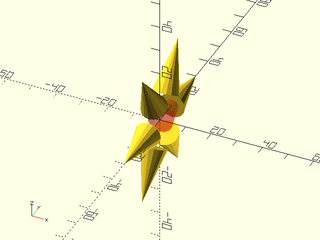
include <BOSL2/std.scad>
xrot_copies(n=6, r=10)
xrot(-90) cylinder(h=20, r1=5, r2=0);
color("red",0.333) xrot(-90) cylinder(h=20, r1=5, r2=0);
Example 4:
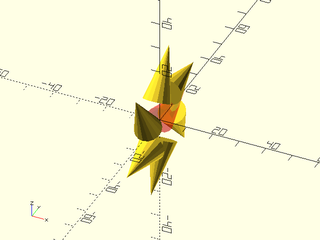
include <BOSL2/std.scad>
xrot_copies(n=6, r=10, sa=45)
xrot(-90) cylinder(h=20, r1=5, r2=0);
color("red",0.333) xrot(-90) cylinder(h=20, r1=5, r2=0);
Example 5:
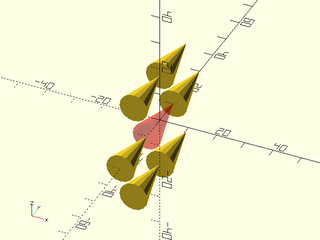
include <BOSL2/std.scad>
xrot_copies(n=6, r=20, subrot=false)
xrot(-90) cylinder(h=20, r1=5, r2=0, center=true);
color("red",0.333) xrot(-90) cylinder(h=20, r1=5, r2=0, center=true);
Synopsis: Rotates copies of children around the Y axis. [MatList] [Trans]
Topics: Transformations, Distributors, Rotation, Copiers
See Also: rot_copies(), xrot_copies(), zrot_copies(), arc_copies(), sphere_copies(), move_copies(), xcopies(), ycopies(), zcopies(), line_copies(), grid_copies()
Usage:
- yrot_copies(rots, [cp], [r=|d=], [sa=], [subrot=]) CHILDREN;
- yrot_copies(n=, [cp=], [r=|d=], [sa=], [subrot=]) CHILDREN;
Usage: As a function to translate points, VNF, or Bezier patches
- copies = yrot_copies(rots, [cp], [r=|d=], [sa=], [subrot=], p=);
- copies = yrot_copies(n=, [cp=], [r=|d=], [sa=], [subrot=], p=);
Usage: Get Translation Matrices
- mats = yrot_copies(rots, [cp], [r=|d=], [sa=], [subrot=]);
- mats = yrot_copies(n=, [cp=], [r=|d=], [sa=], [subrot=]);
Description:
When called as a module:
- Given an array of angles, rotates copies of the children to each of those angles around the Y axis.
- If given a count
n, makes that many copies, rotated evenly around the Y axis. - If given a radius
r(or diameterd), distributes children around a ring of that size around the Y axis. - If given a centerpoint
cp, centers the rotation around that centerpoint. - If
subrotis true, each child will be rotated in place to keep the same size towards the center when making rings. - The first (unrotated) copy will be placed at the relative starting angle
sa.
When called as a function, without a p= argument, returns a list of transformation matrices, one for each copy.
When called as a function, with a p= argument, returns a list of transformed copies of p=.
Arguments:
| By Position | What it does |
|---|---|
rots |
Optional array of rotation angles, in degrees, to make copies at. |
cp |
Centerpoint to rotate around. |
| By Name | What it does |
|---|---|
n |
Optional number of evenly distributed copies to be rotated around the ring. |
sa |
Starting angle, in degrees. For use with n. Angle is in degrees counter-clockwise from X-, when facing the origin from Y+. |
r |
If given, makes a ring of child copies around the Y axis, at the given radius. Default: 0 |
d |
If given, makes a ring of child copies around the Y axis, at the given diameter. |
subrot |
If false, don't sub-rotate children as they are copied around the ring. |
p |
Either a point, pointlist, VNF or Bezier patch to be translated when used as a function. |
Side Effects:
-
$idxis set to the index value of each child copy. -
$angis set to the rotation angle of each child copy, and can be used to modify each child individually. -
$axisis set to the axis vector rotated around.
Example 1:
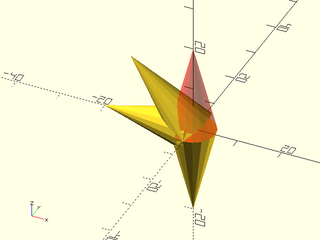
include <BOSL2/std.scad>
yrot_copies([180, 270, 315])
cylinder(h=20, r1=5, r2=0);
color("red",0.333) cylinder(h=20, r1=5, r2=0);
Example 2:

include <BOSL2/std.scad>
yrot_copies(n=6)
cylinder(h=20, r1=5, r2=0);
color("red",0.333) cylinder(h=20, r1=5, r2=0);
Example 3:
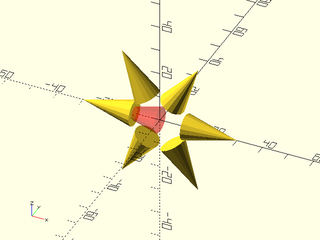
include <BOSL2/std.scad>
yrot_copies(n=6, r=10)
yrot(-90) cylinder(h=20, r1=5, r2=0);
color("red",0.333) yrot(-90) cylinder(h=20, r1=5, r2=0);
Example 4:
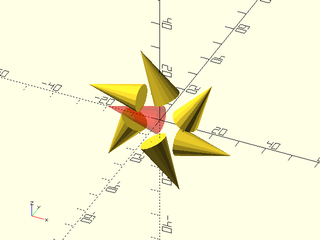
include <BOSL2/std.scad>
yrot_copies(n=6, r=10, sa=45)
yrot(-90) cylinder(h=20, r1=5, r2=0);
color("red",0.333) yrot(-90) cylinder(h=20, r1=5, r2=0);
Example 5:
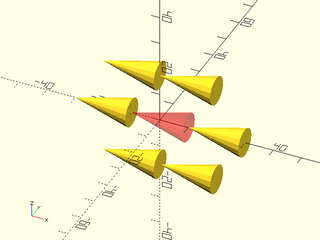
include <BOSL2/std.scad>
yrot_copies(n=6, r=20, subrot=false)
yrot(-90) cylinder(h=20, r1=5, r2=0, center=true);
color("red",0.333) yrot(-90) cylinder(h=20, r1=5, r2=0, center=true);
Synopsis: Rotates copies of children around the Z axis. [MatList] [Trans]
Topics: Transformations, Distributors, Rotation, Copiers
See Also: rot_copies(), xrot_copies(), yrot_copies(), arc_copies(), sphere_copies(), move_copies(), xcopies(), ycopies(), zcopies(), line_copies(), grid_copies()
Usage:
- zrot_copies(rots, [cp], [r=|d=], [sa=], [subrot=]) CHILDREN;
- zrot_copies(n=, [cp=], [r=|d=], [sa=], [subrot=]) CHILDREN;
Usage: As a function to translate points, VNF, or Bezier patches
- copies = zrot_copies(rots, [cp], [r=|d=], [sa=], [subrot=], p=);
- copies = zrot_copies(n=, [cp=], [r=|d=], [sa=], [subrot=], p=);
Usage: Get Translation Matrices
- mats = zrot_copies(rots, [cp], [r=|d=], [sa=], [subrot=]);
- mats = zrot_copies(n=, [cp=], [r=|d=], [sa=], [subrot=]);
Description:
When called as a module:
- Given an array of angles, rotates copies of the children to each of those angles around the Z axis.
- If given a count
n, makes that many copies, rotated evenly around the Z axis. - If given a radius
r(or diameterd), distributes children around a ring of that size around the Z axis. - If given a centerpoint
cp, centers the rotation around that centerpoint. - If
subrotis true, each child will be rotated in place to keep the same size towards the center when making rings. - The first (unrotated) copy will be placed at the relative starting angle
sa.
When called as a function, without a p= argument, returns a list of transformation matrices, one for each copy.
When called as a function, with a p= argument, returns a list of transformed copies of p=.
Arguments:
| By Position | What it does |
|---|---|
rots |
Optional array of rotation angles, in degrees, to make copies at. |
cp |
Centerpoint to rotate around. Default: [0,0,0] |
| By Name | What it does |
|---|---|
n |
Optional number of evenly distributed copies to be rotated around the ring. |
sa |
Starting angle, in degrees. For use with n. Angle is in degrees counter-clockwise from X+, when facing the origin from Z+. Default: 0 |
r |
If given, makes a ring of child copies around the Z axis, at the given radius. Default: 0 |
d |
If given, makes a ring of child copies around the Z axis, at the given diameter. |
subrot |
If false, don't sub-rotate children as they are copied around the ring. Default: true |
p |
Either a point, pointlist, VNF or Bezier patch to be translated when used as a function. |
Side Effects:
-
$idxis set to the index value of each child copy. -
$angis set to the rotation angle of each child copy, and can be used to modify each child individually. -
$axisis set to the axis vector rotated around.
Example 1:
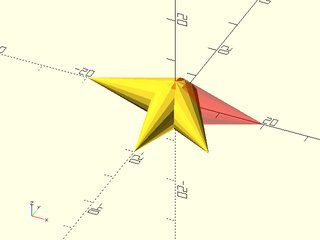
include <BOSL2/std.scad>
zrot_copies([180, 270, 315])
yrot(90) cylinder(h=20, r1=5, r2=0);
color("red",0.333) yrot(90) cylinder(h=20, r1=5, r2=0);
Example 2:
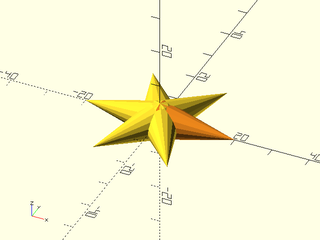
include <BOSL2/std.scad>
zrot_copies(n=6)
yrot(90) cylinder(h=20, r1=5, r2=0);
color("red",0.333) yrot(90) cylinder(h=20, r1=5, r2=0);
Example 3:
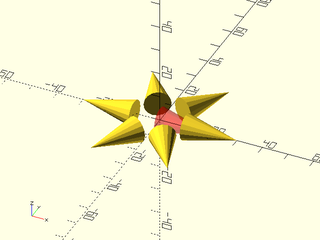
include <BOSL2/std.scad>
zrot_copies(n=6, r=10)
yrot(90) cylinder(h=20, r1=5, r2=0);
color("red",0.333) yrot(90) cylinder(h=20, r1=5, r2=0);
Example 4:
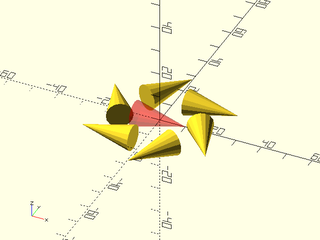
include <BOSL2/std.scad>
zrot_copies(n=6, r=20, sa=45)
yrot(90) cylinder(h=20, r1=5, r2=0, center=true);
color("red",0.333) yrot(90) cylinder(h=20, r1=5, r2=0, center=true);
Example 5:
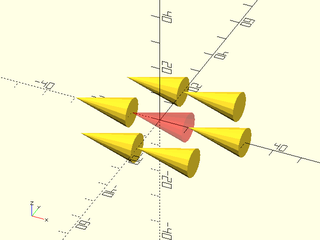
include <BOSL2/std.scad>
zrot_copies(n=6, r=20, subrot=false)
yrot(-90) cylinder(h=20, r1=5, r2=0, center=true);
color("red",0.333) yrot(-90) cylinder(h=20, r1=5, r2=0, center=true);
Synopsis: Distributes duplicates of children along an arc. [MatList] [Trans]
Topics: Transformations, Distributors, Rotation, Copiers
See Also: rot_copies(), xrot_copies(), yrot_copies(), zrot_copies(), sphere_copies(), move_copies(), xcopies(), ycopies(), zcopies(), line_copies(), grid_copies()
Usage:
- arc_copies(n, r|d=, [sa=], [ea=], [rot=]) CHILDREN;
- arc_copies(n, rx=|dx=, ry=|dy=, [sa=], [ea=], [rot=]) CHILDREN;
Usage: As a function to translate points, VNF, or Bezier patches
- copies = arc_copies(n, r|d=, [sa=], [ea=], [rot=], p=);
- copies = arc_copies(n, rx=|dx=, ry=|dy=, [sa=], [ea=], [rot=], p=);
Usage: Get Translation Matrices
- mats = arc_copies(n, r|d=, [sa=], [ea=], [rot=]);
- mats = arc_copies(n, rx=|dx=, ry=|dy=, [sa=], [ea=], [rot=]);
Description:
When called as a module, evenly distributes n duplicate children around an ovoid arc on the XY plane.
When called as a function, without a p= argument, returns a list of transformation matrices, one for each copy.
When called as a function, with a p= argument, returns a list of transformed copies of p=.
Arguments:
| By Position | What it does |
|---|---|
n |
number of copies to distribute around the circle. (Default: 6) |
r |
radius of circle (Default: 1) |
| By Name | What it does |
|---|---|
rx |
radius of ellipse on X axis. Used instead of r. |
ry |
radius of ellipse on Y axis. Used instead of r. |
d |
diameter of circle. (Default: 2) |
dx |
diameter of ellipse on X axis. Used instead of d. |
dy |
diameter of ellipse on Y axis. Used instead of d. |
rot |
whether to rotate the copied children. (Default: true) |
sa |
starting angle. (Default: 0.0) |
ea |
ending angle. Will distribute copies CCW from sa to ea. (Default: 360.0) |
p |
Either a point, pointlist, VNF or Bezier patch to be translated when used as a function. |
Side Effects:
-
$angis set to the rotation angle of each child copy, and can be used to modify each child individually. -
$posis set to the relative centerpoint of each child copy, and can be used to modify each child individually. -
$idxis set to the index value of each child copy.
Example 1:

include <BOSL2/std.scad>
#cube(size=[10,3,3],center=true);
arc_copies(d=40, n=5) cube(size=[10,3,3],center=true);
Example 2:
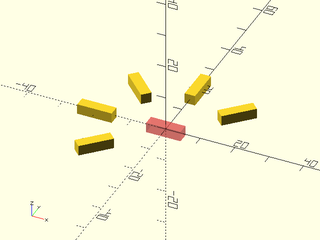
include <BOSL2/std.scad>
#cube(size=[10,3,3],center=true);
arc_copies(d=40, n=5, sa=45, ea=225) cube(size=[10,3,3],center=true);
Example 3:
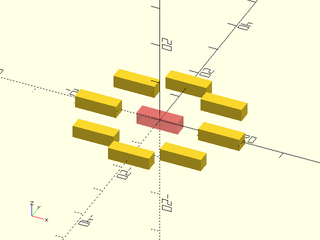
include <BOSL2/std.scad>
#cube(size=[10,3,3],center=true);
arc_copies(r=15, n=8, rot=false) cube(size=[10,3,3],center=true);
Example 4:
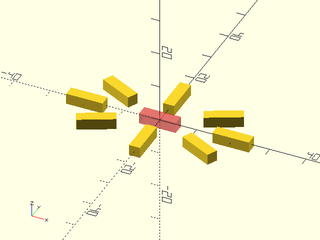
include <BOSL2/std.scad>
#cube(size=[10,3,3],center=true);
arc_copies(rx=20, ry=10, n=8) cube(size=[10,3,3],center=true);
Example 5: Using $idx to alternate shapes
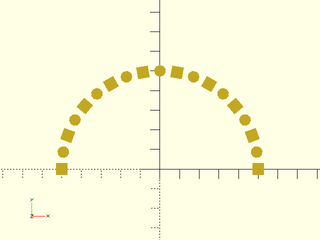
include <BOSL2/std.scad>
arc_copies(r=50, n=19, sa=0, ea=180)
if ($idx % 2 == 0) rect(6);
else circle(d=6);
Synopsis: Distributes copies of children over the surface of a sphere. [MatList] [Trans]
Topics: Transformations, Distributors, Rotation, Copiers
See Also: rot_copies(), xrot_copies(), yrot_copies(), zrot_copies(), arc_copies(), move_copies(), xcopies(), ycopies(), zcopies(), line_copies(), grid_copies()
Usage:
- sphere_copies(n, r|d=, [cone_ang=], [scale=], [perp=]) CHILDREN;
Usage: As a function to translate points, VNF, or Bezier patches
- copies = sphere_copies(n, r|d=, [cone_ang=], [scale=], [perp=], p=);
Usage: Get Translation Matrices
- mats = sphere_copies(n, r|d=, [cone_ang=], [scale=], [perp=]);
Description:
When called as a module, spreads children semi-evenly over the surface of a sphere or ellipsoid.
When called as a function, without a p= argument, returns a list of transformation matrices, one for each copy.
When called as a function, with a p= argument, returns a list of transformed copies of p=.
Arguments:
| By Position | What it does |
|---|---|
n |
How many copies to evenly spread over the surface. |
r |
Radius of the sphere to distribute over |
| By Name | What it does |
|---|---|
d |
Diameter of the sphere to distribute over |
cone_ang |
Angle of the cone, in degrees, to limit how much of the sphere gets covered. For full sphere coverage, use 180. Measured pre-scaling. Default: 180 |
scale |
The [X,Y,Z] scaling factors to reshape the sphere being covered. |
perp |
If true, rotate children to be perpendicular to the sphere surface. Default: true |
p |
Either a point, pointlist, VNF or Bezier patch to be translated when used as a function. |
Side Effects:
-
$posis set to the relative post-scaled centerpoint of each child copy, and can be used to modify each child individually. -
$thetais set to the theta angle of the child from the center of the sphere. -
$phiis set to the pre-scaled phi angle of the child from the center of the sphere. -
$radis set to the pre-scaled radial distance of the child from the center of the sphere. -
$idxis set to the index number of each child being copied.
Example 1:
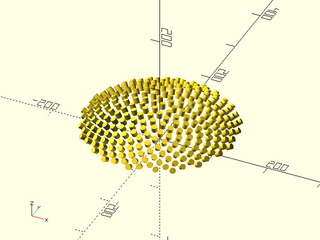
include <BOSL2/std.scad>
sphere_copies(n=250, d=100, cone_ang=45, scale=[3,3,1])
cylinder(d=10, h=10, center=false);
Example 2:
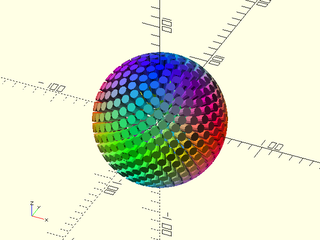
include <BOSL2/std.scad>
sphere_copies(n=500, d=100, cone_ang=180)
color(unit(point3d(v_abs($pos))))
cylinder(d=8, h=10, center=false);
Synopsis: Uniformly distributes copies of children along a path. [MatList] [Trans]
Topics: Transformations, Distributors, Copiers
See Also: line_copies(), move_copies(), xcopies(), ycopies(), zcopies(), grid_copies(), xflip_copy(), yflip_copy(), zflip_copy(), mirror_copy()
Usage: Uniformly distribute copies
- path_copies(path, [n], [spacing], [sp], [rotate_children], [closed=]) CHILDREN;
Usage: Place copies at specified locations
- path_copies(path, dist=, [rotate_children=], [closed=]) CHILDREN;
Usage: As a function to translate points, VNF, or Bezier patches
- copies = path_copies(path, [n], [spacing], [sp], [rotate_children], [closed=], p=);
- copies = path_copies(path, dist=, [rotate_children=], [closed=], p=);
Usage: Get Translation Matrices
- mats = path_copies(path, [n], [spacing], [sp], [rotate_children], [closed=]);
- mats = path_copies(path, dist=, [rotate_children=], [closed=]);
Description:
When called as a module:
- Place copies all of the children at points along the path based on path length. You can specify
distas - a scalar or distance list and the children will be placed at the specified distances from the start of the path. Otherwise the children are
- placed at uniformly spaced points along the path. If you specify
nbut notspacingthenncopies will be placed - with one at path[0] if
closedis true, or spanning the entire path from start to end ifclosedis false. - If you specify
spacingbut notnthen copies will spread out starting from one set at path[0] forclosed=trueor at the path center for open paths. - If you specify
spthen the copies will start at distancespfrom the start of the path.
When called as a function, without a p= argument, returns a list of transformation matrices, one for each copy.
When called as a function, with a p= argument, returns a list of transformed copies of p=.
Arguments:
| By Position | What it does |
|---|---|
path |
path or 1-region where children are placed |
n |
number of copies |
spacing |
space between copies |
sp |
if given, copies will start distance sp from the path start and spread beyond that point |
rotate_children |
if true, rotate children to line up with curve normal. Default: true |
| By Name | What it does |
|---|---|
dist |
Specify a list of distances to determine placement of children. |
closed |
If true treat path as a closed curve. Default: false |
p |
Either a point, pointlist, VNF or Bezier patch to be translated when used as a function. |
Side Effects:
-
$posis set to the center of each copy -
$idxis set to the index number of each copy. In the case of closed paths the first copy is atpath[0]unless you givesp. -
$diris set to the direction vector of the path at the point where the copy is placed. -
$normalis set to the direction of the normal vector to the path direction that is coplanar with the path at this point
Example 1:
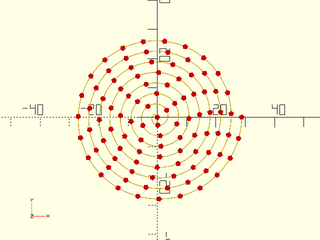
include <BOSL2/std.scad>
spiral = [for(theta=[0:360*8]) theta * [cos(theta), sin(theta)]]/100;
stroke(spiral,width=.25);
color("red") path_copies(spiral, n=100) circle(r=1);
Example 2:
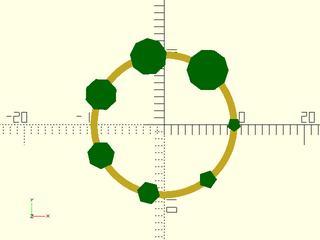
include <BOSL2/std.scad>
circle = regular_ngon(n=64, or=10);
stroke(circle,width=1,closed=true);
color("green") path_copies(circle, n=7, closed=true) circle(r=1+$idx/3);
Example 3:
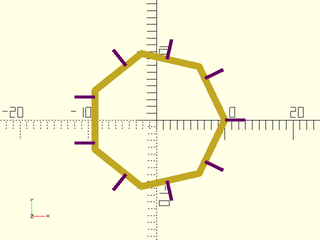
include <BOSL2/std.scad>
heptagon = regular_ngon(n=7, or=10);
stroke(heptagon, width=1, closed=true);
color("purple") path_copies(heptagon, n=9, closed=true) rect([0.5,3],anchor=FRONT);
Example 4: Direction at the corners is the average of the two adjacent edges

include <BOSL2/std.scad>
heptagon = regular_ngon(n=7, or=10);
stroke(heptagon, width=1, closed=true);
color("purple") path_copies(heptagon, n=7, closed=true) rect([0.5,3],anchor=FRONT);
Example 5: Don't rotate the children
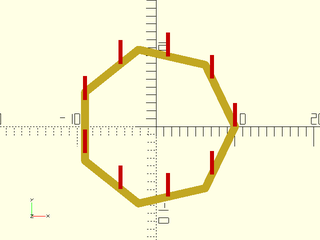
include <BOSL2/std.scad>
heptagon = regular_ngon(n=7, or=10);
stroke(heptagon, width=1, closed=true);
color("red") path_copies(heptagon, n=9, closed=true, rotate_children=false) rect([0.5,3],anchor=FRONT);
Example 6: Open path, specify n

include <BOSL2/std.scad>
sinwav = [for(theta=[0:360]) 5*[theta/180, sin(theta)]];
stroke(sinwav,width=.1);
color("red") path_copies(sinwav, n=5) rect([.2,1.5],anchor=FRONT);
Example 7: Open path, specify n and spacing
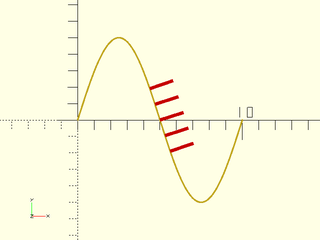
include <BOSL2/std.scad>
sinwav = [for(theta=[0:360]) 5*[theta/180, sin(theta)]];
stroke(sinwav,width=.1);
color("red") path_copies(sinwav, n=5, spacing=1) rect([.2,1.5],anchor=FRONT);
Example 8: Closed path, specify n and spacing, copies centered around circle[0]
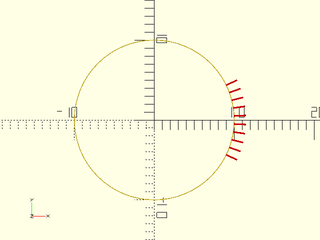
include <BOSL2/std.scad>
circle = regular_ngon(n=64,or=10);
stroke(circle,width=.1,closed=true);
color("red") path_copies(circle, n=10, spacing=1, closed=true) rect([.2,1.5],anchor=FRONT);
Example 9: Open path, specify spacing
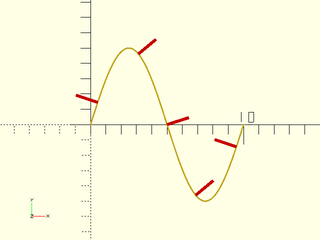
include <BOSL2/std.scad>
sinwav = [for(theta=[0:360]) 5*[theta/180, sin(theta)]];
stroke(sinwav,width=.1);
color("red") path_copies(sinwav, spacing=5) rect([.2,1.5],anchor=FRONT);
Example 10: Open path, specify sp
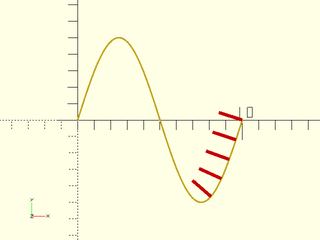
include <BOSL2/std.scad>
sinwav = [for(theta=[0:360]) 5*[theta/180, sin(theta)]];
stroke(sinwav,width=.1);
color("red") path_copies(sinwav, n=5, sp=18) rect([.2,1.5],anchor=FRONT);
Example 11: Open path, specify dist

include <BOSL2/std.scad>
sinwav = [for(theta=[0:360]) 5*[theta/180, sin(theta)]];
stroke(sinwav,width=.1);
color("red") path_copies(sinwav, dist=[1,4,9,16]) rect([.2,1.5],anchor=FRONT);
Example 12:
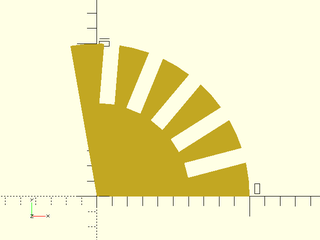
include <BOSL2/std.scad>
wedge = arc(angle=[0,100], r=10, $fn=64);
difference(){
polygon(concat([[0,0]],wedge));
path_copies(wedge,n=5,spacing=3) fwd(.1) rect([1,4],anchor=FRONT);
}
Example 13: 3d example, with children rotated into the plane of the path
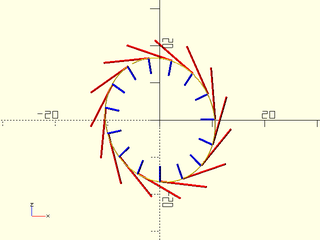
include <BOSL2/std.scad>
tilted_circle = lift_plane([[0,0,0], [5,0,5], [0,2,3]],regular_ngon(n=64, or=12));
path_sweep(regular_ngon(n=16,or=.1),tilted_circle);
path_copies(tilted_circle, n=15,closed=true) {
color("blue") cyl(h=3,r=.2, anchor=BOTTOM); // z-aligned cylinder
color("red") xcyl(h=10,r=.2, anchor=FRONT+LEFT); // x-aligned cylinder
}
Example 14: 3d example, with rotate_children set to false

include <BOSL2/std.scad>
tilted_circle = lift_plane([[0,0,0], [5,0,5], [0,2,3]], regular_ngon(n=64, or=12));
path_sweep(regular_ngon(n=16,or=.1),tilted_circle);
path_copies(tilted_circle, n=25,rotate_children=false,closed=true) {
color("blue") cyl(h=3,r=.2, anchor=BOTTOM); // z-aligned cylinder
color("red") xcyl(h=10,r=.2, anchor=FRONT+LEFT); // x-aligned cylinder
}
Synopsis: Makes a copy of children mirrored across the X axis. [MatList] [Trans]
Topics: Transformations, Distributors, Translation, Copiers
See Also: yflip_copy(), zflip_copy(), mirror_copy(), path_copies(), move_copies(), xcopies(), ycopies(), zcopies(), line_copies(), grid_copies()
Usage:
- xflip_copy([offset], [x]) CHILDREN;
Usage: As a function to translate points, VNF, or Bezier patches
- copies = xflip_copy([offset], [x], p=);
Usage: Get Translation Matrices
- mats = xflip_copy([offset], [x]);
Description:
When called as a module, makes a copy of the children, mirrored across the X axis.
When called as a function, without a p= argument, returns a list of transformation matrices, one for each copy.
When called as a function, with a p= argument, returns a list of transformed copies of p=.
Arguments:
| By Position | What it does |
|---|---|
offset |
Distance to offset children right, before copying. |
x |
The X coordinate of the mirroring plane. Default: 0 |
| By Name | What it does |
|---|---|
p |
Either a point, pointlist, VNF or Bezier patch to be translated when used as a function. |
Side Effects:
-
$origis true for the original instance of children. False for the copy. -
$idxis set to the index value of each copy.
Example 1:
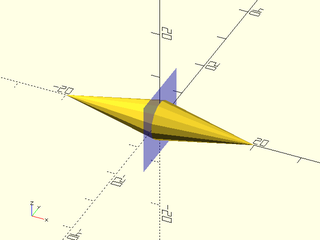
include <BOSL2/std.scad>
xflip_copy() yrot(90) cylinder(h=20, r1=4, r2=0);
color("blue",0.25) cube([0.01,15,15], center=true);
Example 2:
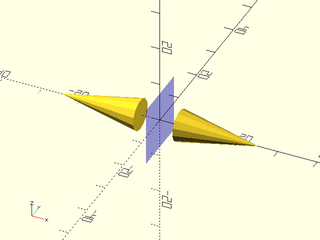
include <BOSL2/std.scad>
xflip_copy(offset=5) yrot(90) cylinder(h=20, r1=4, r2=0);
color("blue",0.25) cube([0.01,15,15], center=true);
Example 3:

include <BOSL2/std.scad>
xflip_copy(x=-5) yrot(90) cylinder(h=20, r1=4, r2=0);
color("blue",0.25) left(5) cube([0.01,15,15], center=true);
Synopsis: Makes a copy of children mirrored across the Y axis. [MatList] [Trans]
Topics: Transformations, Distributors, Translation, Copiers
See Also: xflip_copy(), zflip_copy(), mirror_copy(), path_copies(), move_copies(), xcopies(), ycopies(), zcopies(), line_copies(), grid_copies()
Usage:
- yflip_copy([offset], [y]) CHILDREN;
Usage: As a function to translate points, VNF, or Bezier patches
- copies = yflip_copy([offset], [y], p=);
Usage: Get Translation Matrices
- mats = yflip_copy([offset], [y]);
Description:
When called as a module, makes a copy of the children, mirrored across the Y axis.
When called as a function, without a p= argument, returns a list of transformation matrices, one for each copy.
When called as a function, with a p= argument, returns a list of transformed copies of p=.
Arguments:
| By Position | What it does |
|---|---|
offset |
Distance to offset children back, before copying. |
y |
The Y coordinate of the mirroring plane. Default: 0 |
| By Name | What it does |
|---|---|
p |
Either a point, pointlist, VNF or Bezier patch to be translated when used as a function. |
Side Effects:
-
$origis true for the original instance of children. False for the copy. -
$idxis set to the index value of each copy.
Example 1:

include <BOSL2/std.scad>
yflip_copy() xrot(-90) cylinder(h=20, r1=4, r2=0);
color("blue",0.25) cube([15,0.01,15], center=true);
Example 2:

include <BOSL2/std.scad>
yflip_copy(offset=5) xrot(-90) cylinder(h=20, r1=4, r2=0);
color("blue",0.25) cube([15,0.01,15], center=true);
Example 3:
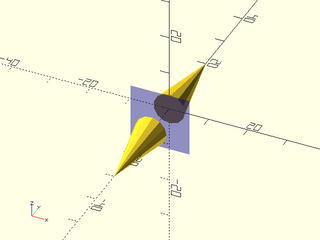
include <BOSL2/std.scad>
yflip_copy(y=-5) xrot(-90) cylinder(h=20, r1=4, r2=0);
color("blue",0.25) fwd(5) cube([15,0.01,15], center=true);
Synopsis: Makes a copy of children mirrored across the Z axis. [MatList] [Trans]
Topics: Transformations, Distributors, Translation, Copiers
See Also: xflip_copy(), yflip_copy(), mirror_copy(), path_copies(), move_copies(), xcopies(), ycopies(), zcopies(), line_copies(), grid_copies()
Usage:
- zflip_copy([offset], [z]) CHILDREN;
Usage: As a function to translate points, VNF, or Bezier patches
- copies = zflip_copy([offset], [z], p=);
Usage: Get Translation Matrices
- mats = zflip_copy([offset], [z]);
Description:
When called as a module, makes a copy of the children, mirrored across the Z axis.
When called as a function, without a p= argument, returns a list of transformation matrices, one for each copy.
When called as a function, with a p= argument, returns a list of transformed copies of p=.
Arguments:
| By Position | What it does |
|---|---|
offset |
Distance to offset children up, before copying. |
z |
The Z coordinate of the mirroring plane. Default: 0 |
| By Name | What it does |
|---|---|
p |
Either a point, pointlist, VNF or Bezier patch to be translated when used as a function. |
Side Effects:
-
$origis true for the original instance of children. False for the copy. -
$idxis set to the index value of each copy.
Example 1:
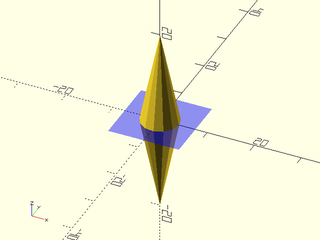
include <BOSL2/std.scad>
zflip_copy() cylinder(h=20, r1=4, r2=0);
color("blue",0.25) cube([15,15,0.01], center=true);
Example 2:

include <BOSL2/std.scad>
zflip_copy(offset=5) cylinder(h=20, r1=4, r2=0);
color("blue",0.25) cube([15,15,0.01], center=true);
Example 3:
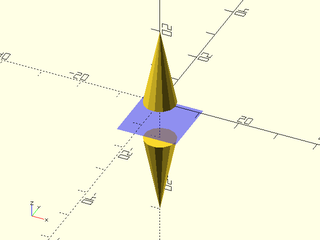
include <BOSL2/std.scad>
zflip_copy(z=-5) cylinder(h=20, r1=4, r2=0);
color("blue",0.25) down(5) cube([15,15,0.01], center=true);
Synopsis: Makes a copy of children mirrored across a given plane. [MatList] [Trans]
Topics: Transformations, Distributors, Translation, Copiers
See Also: xflip_copy(), yflip_copy(), zflip_copy(), path_copies(), move_copies(), xcopies(), ycopies(), zcopies(), line_copies(), grid_copies()
Usage:
- mirror_copy(v, [cp], [offset]) CHILDREN;
Usage: As a function to translate points, VNF, or Bezier patches
- copies = mirror_copy(v, [cp], [offset], p=);
Usage: Get Translation Matrices
- mats = mirror_copy(v, [cp], [offset]);
Description:
When called as a module, makes a copy of the children, mirrored across the given plane.
When called as a function, without a p= argument, returns a list of transformation matrices, one for each copy.
When called as a function, with a p= argument, returns a list of transformed copies of p=.
Arguments:
| By Position | What it does |
|---|---|
v |
The normal vector of the plane to mirror across. |
offset |
distance to offset away from the plane. |
cp |
A point that lies on the mirroring plane. |
| By Name | What it does |
|---|---|
p |
Either a point, pointlist, VNF or Bezier patch to be translated when used as a function. |
Side Effects:
-
$origis true for the original instance of children. False for the copy. -
$idxis set to the index value of each copy.
Example 1:
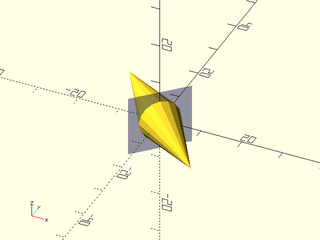
include <BOSL2/std.scad>
mirror_copy([1,-1,0]) zrot(-45) yrot(90) cylinder(d1=10, d2=0, h=20);
color("blue",0.25) zrot(-45) cube([0.01,15,15], center=true);
Example 2:
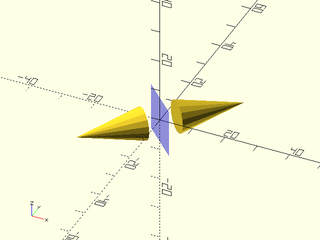
include <BOSL2/std.scad>
mirror_copy([1,1,0], offset=5) rot(a=90,v=[-1,1,0]) cylinder(d1=10, d2=0, h=20);
color("blue",0.25) zrot(45) cube([0.01,15,15], center=true);
Example 3:

include <BOSL2/std.scad>
mirror_copy(UP+BACK, cp=[0,-5,-5]) rot(from=UP, to=BACK+UP) cylinder(d1=10, d2=0, h=20);
color("blue",0.25) translate([0,-5,-5]) rot(from=UP, to=BACK+UP) cube([15,15,0.01], center=true);
Synopsis: Distributes each child, individually, out along the X axis. [Trans]
See Also: ydistribute(), zdistribute(), distribute()
Usage:
- xdistribute(spacing, [sizes]) CHILDREN;
- xdistribute(l=, [sizes=]) CHILDREN;
Description:
Spreads out the children individually along the X axis. Every child is placed at a different position, in order. This is useful for laying out groups of disparate objects where you only really care about the spacing between them.
Arguments:
| By Position | What it does |
|---|---|
spacing |
spacing between each child. (Default: 10.0) |
sizes |
Array containing how much space each child will need. |
l |
Length to distribute copies along. |
Side Effects:
-
$posis set to the relative centerpoint of each child copy, and can be used to modify each child individually. -
$idxis set to the index number of each child being copied.
Example 1:
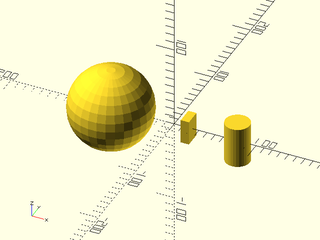
include <BOSL2/std.scad>
xdistribute(sizes=[100, 10, 30], spacing=40) {
sphere(r=50);
cube([10,20,30], center=true);
cylinder(d=30, h=50, center=true);
}
Synopsis: Distributes each child, individually, out along the Y axis. [Trans]
See Also: xdistribute(), zdistribute(), distribute()
Usage:
- ydistribute(spacing, [sizes]) CHILDREN;
- ydistribute(l=, [sizes=]) CHILDREN;
Description:
Spreads out the children individually along the Y axis. Every child is placed at a different position, in order. This is useful for laying out groups of disparate objects where you only really care about the spacing between them.
Arguments:
| By Position | What it does |
|---|---|
spacing |
spacing between each child. (Default: 10.0) |
sizes |
Array containing how much space each child will need. |
l |
Length to distribute copies along. |
Side Effects:
-
$posis set to the relative centerpoint of each child copy, and can be used to modify each child individually. -
$idxis set to the index number of each child being copied.
Example 1:
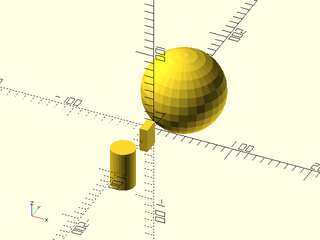
include <BOSL2/std.scad>
ydistribute(sizes=[30, 20, 100], spacing=40) {
cylinder(d=30, h=50, center=true);
cube([10,20,30], center=true);
sphere(r=50);
}
Synopsis: Distributes each child, individually, out along the Z axis. [Trans]
See Also: xdistribute(), ydistribute(), distribute()
Usage:
- zdistribute(spacing, [sizes]) CHILDREN;
- zdistribute(l=, [sizes=]) CHILDREN;
Description:
Spreads out each individual child along the Z axis. Every child is placed at a different position, in order. This is useful for laying out groups of disparate objects where you only really care about the spacing between them.
Arguments:
| By Position | What it does |
|---|---|
spacing |
spacing between each child. (Default: 10.0) |
sizes |
Array containing how much space each child will need. |
l |
Length to distribute copies along. |
Side Effects:
-
$posis set to the relative centerpoint of each child copy, and can be used to modify each child individually. -
$idxis set to the index number of each child being copied.
Example 1:
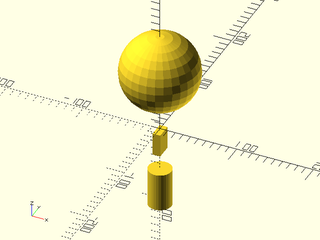
include <BOSL2/std.scad>
zdistribute(sizes=[30, 20, 100], spacing=40) {
cylinder(d=30, h=50, center=true);
cube([10,20,30], center=true);
sphere(r=50);
}
Synopsis: Distributes each child, individually, out along an arbitrary line. [Trans]
See Also: xdistribute(), ydistribute(), zdistribute()
Usage:
- distribute(spacing, sizes, dir) CHILDREN;
- distribute(l=, [sizes=], [dir=]) CHILDREN;
Description:
Spreads out the children individually along the direction dir.
Every child is placed at a different position, in order.
This is useful for laying out groups of disparate objects
where you only really care about the spacing between them.
Arguments:
| By Position | What it does |
|---|---|
spacing |
Spacing to add between each child. (Default: 10.0) |
sizes |
Array containing how much space each child will need. |
dir |
Vector direction to distribute copies along. Default: RIGHT |
l |
Length to distribute copies along. |
Side Effects:
-
$posis set to the relative centerpoint of each child copy, and can be used to modify each child individually. -
$idxis set to the index number of each child being copied.
Example 1:

include <BOSL2/std.scad>
distribute(sizes=[100, 30, 50], dir=UP) {
sphere(r=50);
cube([10,20,30], center=true);
cylinder(d=30, h=50, center=true);
}
Table of Contents
Function Index
Topics Index
Cheat Sheet
Tutorials
Basic Modeling:
- constants.scad STD
- transforms.scad STD
- attachments.scad STD
- shapes2d.scad STD
- shapes3d.scad STD
- drawing.scad STD
- masks2d.scad STD
- masks3d.scad STD
- distributors.scad STD
- color.scad STD
- partitions.scad STD
- mutators.scad STD
Advanced Modeling:
Math:
- math.scad STD
- linalg.scad STD
- vectors.scad STD
- coords.scad STD
- geometry.scad STD
- trigonometry.scad STD
Data Management:
- version.scad STD
- comparisons.scad STD
- lists.scad STD
- utility.scad STD
- strings.scad STD
- structs.scad
- fnliterals.scad
Threaded Parts:
Parts:
- ball_bearings.scad
- cubetruss.scad
- gears.scad
- hinges.scad
- joiners.scad
- linear_bearings.scad
- modular_hose.scad
- nema_steppers.scad
- polyhedra.scad
- sliders.scad
- tripod_mounts.scad
- walls.scad
- wiring.scad
STD = Included in std.scad